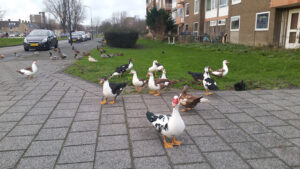Duck plague in Muscovy ducks

Photo: Marianne Biesma
Duck plague was found to be the cause of death in three Muscovy Ducks (Cairina moschata) from Midden-Kennemerland, a region in North Holland. These ducks were part of a group of 15 Muscovy ducks with five adults (approximately eight years old), and ten younger birds (approximately six months old). After the first death at the beginning of May all 15 animals had died by early June. Three ducks were submitted to the DWHC for an investigation into the death of the group. Autopsy revealed these deaths to be caused by duck plague.
The signs reported by the animal ambulance workers included general weakness and loss of appetite with walking becoming increasingly difficult for the birds which would collapse after walking short distances. At this point the female ducks died whilst death of the male ducks was preceded by an additional phase of shivering in which their heads turned blue.
Duck plague is a very infectious disease caused by Anatid herpesvirus-1. The disease was first reported in The Netherlands in 1923 when it was initially believed to be a novel form of bird flu. Only years later was it discovered that it is caused by a member of the herpes viruses.
Ducks, geese and swans (members of the family Anatidae, order Anseriformes) can be infected, although susceptibility varies among species; Muscovy ducks are highly sensitive to infection.
In the USA outbreaks of duck plague are reported to occur predominantly between March and June. At this time of year the combination of weather conditions, the grouping of large numbers of migrating birds, and other physiological stresses such as breeding, overcrowding and competition for food/mates renders the birds vulnerable to infection. The virus is spread via the beak and the cloaca. Not all infected birds become ill and some may recover: These birds can carry and spread the virus without showing any signs. It is not possible to identify birds infected with this virus by external exam alone.
Whilst duck plague does not pose a threat to other birds or mammals (including humans), it is a notifiable disease in some countries including The Netherlands. There is no proven treatment protocol for an outbreak and the most important action is to prevent the spread of the disease to other waterfowl populations in the area. As overcrowding can contribute to virus outbreaks it is recommended not to feed wild ducks, geese and swans. Vaccines are available and may be used to protect domestic waterfowl.
For more information about when and how to report multiple deaths in wild animals and birds please refer to our guide Vogelsterfteschema (in Dutch).
Sources:
Hansen, W.R. & R. E. Cough, (2007) Duck Plague (Duck Virus Enteritis). In Thomas, N.J., D.B. Hunter & C.T. Atkinson (Ed), Infectious Diseases of Wild Birds (pp 87 – 107)



